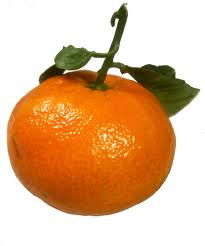 The tangerine, also known as the Mandarin Orange, is a sweet fruit with a deep orange color. Similar to an orange, the tangerine is known for its more tart taste and gentler texture. The tangerine derived from Asia, where it is still widely grown and known as the Mandarin orange. With this said, the tangerine we enjoy today was developed on the Mediterranean in the city of Tangier. This variety produced a smaller fruit than an orange, with a skin which can be more easily removed. The ease in which the skin of the fruit can be removed also creates problems for shipping, which is why tangerines tend to be more expensive than their orange counterparts. With a short season lasting from November until January in tropical areas, be sure to satisfy your tangerine cravings before this fruit recedes until the following season.
The tangerine, also known as the Mandarin Orange, is a sweet fruit with a deep orange color. Similar to an orange, the tangerine is known for its more tart taste and gentler texture. The tangerine derived from Asia, where it is still widely grown and known as the Mandarin orange. With this said, the tangerine we enjoy today was developed on the Mediterranean in the city of Tangier. This variety produced a smaller fruit than an orange, with a skin which can be more easily removed. The ease in which the skin of the fruit can be removed also creates problems for shipping, which is why tangerines tend to be more expensive than their orange counterparts. With a short season lasting from November until January in tropical areas, be sure to satisfy your tangerine cravings before this fruit recedes until the following season.
Key Nutrients
Tangerines are a great source of flavonoids, potassium, folic acid and vitamin C. They are also a great source of dietary fiber and are low in both saturated and unsaturated fat.
Health Benefits
Flavonoids – Flavonoids are a class of antioxidants which help to promote healthy cell growth and reduce inflammation. They are also a powerful class of molecules when it comes to reducing the risk of certain cancers.
Vitamin C – Regular consumption of foods rich in vitamin C helps the body develop resistance against infections and scavenges harmful, pro-inflammatory free radicals. Vitamin C also helps to prevent respiratory problems such as asthma and lung cancer. Vitamin C has been shown to lower blood pressure, and therefore lessen the probability of hypertension.
Vitamin B12 – Vitamin B12, or folic acid, helps to preserve neurological function and DNA synthesis. It also plays a key role in the health of red blood cells. The nervous system relies on vitamin B12 for proper function as well.
Potassium – Potassium is an essential mineral which aids in fluid regulation, protein synthesis and cardiovascular health. High levels of potassium are associated with reduced risk for stroke, improved blood pressure control as well as bone health.
Season
Tangerines are available in the Northern Hemisphere from October to April in the Northern hemisphere, and from April to October in the Southern Hemisphere, making them available year round in many markets.
Nutrition Information
Per 1 Fruit (88 grams):
Calories (cKal): 47
Protein (grams): .71
Total Fat (grams): .27
Carbohydrates (grams): 11.74
Fiber (grams): 1.6
Buying and Storing
When buying tangerines, make sure the fruit is soft to the touch and free of blemishes. When storing at home, the fruit can last on your countertop for up to ten days, on in your refrigerator for up to two weeks.
Best Way to Add to Diet
Tangerines are best enjoyed raw as a morning meal or afternoon snack. Try adding a few tangerine segments to a salad for an unexpected treat. Tangerines work well in any dessert, especially a fruit salad or as a sorbet.
Tangerine Recipe
Tangerine and Watercress Salad

 Not Sure What Healthy Foods To Eat?
Not Sure What Healthy Foods To Eat? This week we take a look at one of my favorite healthy foods...the mighty Avocado.
This week we take a look at one of my favorite healthy foods...the mighty Avocado.
No comments yet.